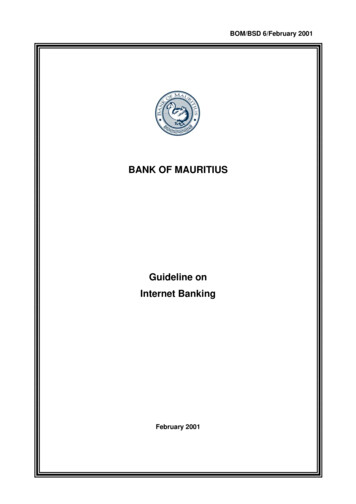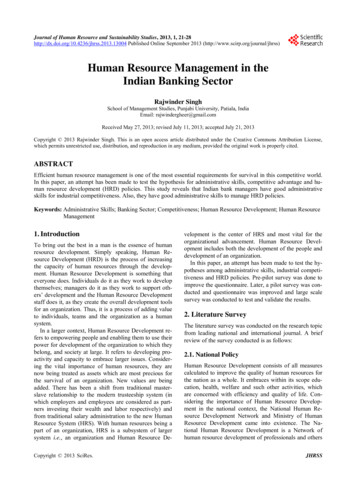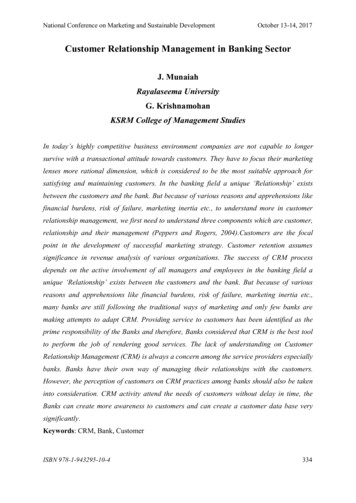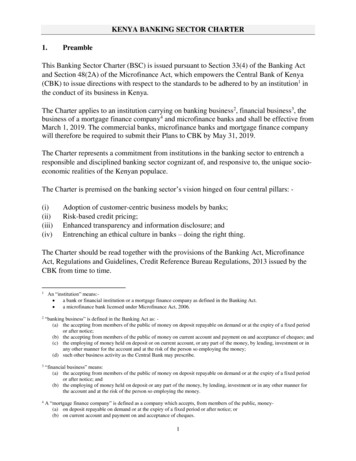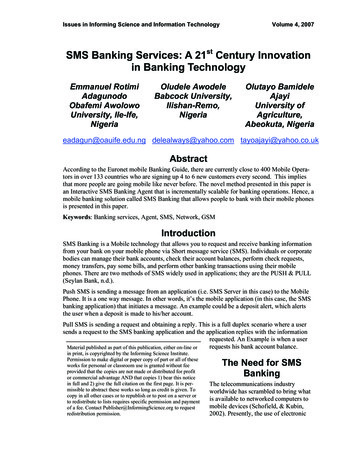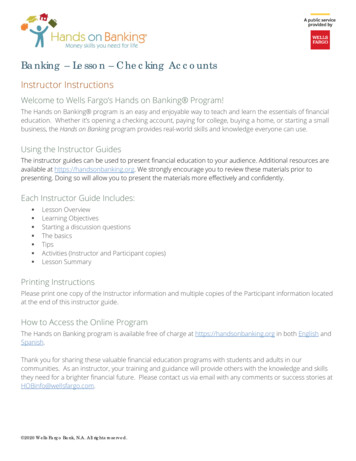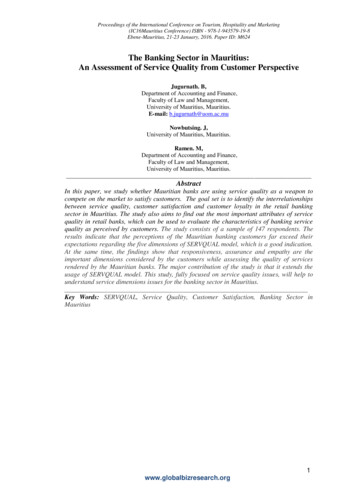
Transcription
Proceedings of the International Conference on Tourism, Hospitality and Marketing(IC16Mauritius Conference) ISBN - 978-1-943579-19-8Ebene-Mauritius, 21-23 January, 2016. Paper ID: M624The Banking Sector in Mauritius:An Assessment of Service Quality from Customer PerspectiveJugurnath. B,Department of Accounting and Finance,Faculty of Law and Management,University of Mauritius, Mauritius.E-mail: b.jugurnath@uom.ac.muNowbutsing. J,University of Mauritius, Mauritius.Ramen. M,Department of Accounting and Finance,Faculty of Law and Management,University of Mauritius, Mauritius.AbstractIn this paper, we study whether Mauritian banks are using service quality as a weapon tocompete on the market to satisfy customers. The goal set is to identify the interrelationshipsbetween service quality, customer satisfaction and customer loyalty in the retail bankingsector in Mauritius. The study also aims to find out the most important attributes of servicequality in retail banks, which can be used to evaluate the characteristics of banking servicequality as perceived by customers. The study consists of a sample of 147 respondents. Theresults indicate that the perceptions of the Mauritian banking customers far exceed theirexpectations regarding the five dimensions of SERVQUAL model, which is a good indication.At the same time, the findings show that responsiveness, assurance and empathy are theimportant dimensions considered by the customers while assessing the quality of servicesrendered by the Mauritian banks. The major contribution of the study is that it extends theusage of SERVQUAL model. This study, fully focused on service quality issues, will help tounderstand service dimensions issues for the banking sector in Mauritius.Key Words: SERVQUAL, Service Quality, Customer Satisfaction, Banking Sector inMauritius1www.globalbizresearch.org
Proceedings of the International Conference on Tourism, Hospitality and Marketing(IC16Mauritius Conference) ISBN - 978-1-943579-19-8Ebene-Mauritius, 21-23 January, 2016. Paper ID: M6241. IntroductionThe Banking sector has always been dynamic and resilient with high levels ofcompetition. Banks use various strategies to protect their existing portfolio of customers andbuild upon new ones so as to ensure business growth. Quality and marketing tools are theessential factors that can contribute to the bank’s inner corporate objectives. In Mauritius,there has been a continual propagation of banks through time, where only a few commercialbanks existed prior to its independence. At present, there are 21 banks, out of which 7 arelocal banks, 8 are foreign-owned subsidiaries, 1 is a joint-venture and 5 are branches offoreign banks. These banks are allowed to conduct banking transactions both onshore andoffshore. The banks in Mauritius are licensed and regulated by the Bank of Mauritius (BOM),mandated by law as Central Bank to administer a strong regulatory framework. In order tocreate a harmonization in the Mauritian banking industry, BOM has issued guidelines underthe name of Bank of Mauritius Act (2004), Banking Act (2004) and a series of rules thatoversee the daily operations of banks. The banking sector has played a key function in thedevelopment of the Mauritian economy as they are expected to play in any other modern freeorientated economy. This industry employs more than 5,000 professionals, contributing toaround 6% of GDP. For this study, only five of the most popular banks have been selected forthis paper, namely the state bank of Mauritius (SBM) ltd, the Mauritius Commercial Bank(MCB) LTD, Barclays Bank Mauritius Limited, hongkong&shanghai bank cooperation(HSBC) ltd and bramer banking corporation ltd. Service Quality has become a substantialcomponent of the banking industry – at least as a competitive tool. It becomes useful tomeasure the effectiveness of service quality correctly. Hence, this study assesses the servicequality offered by commercial banks in Mauritius - from a customer’s perspective withemphasis on what customers expect on the level of quality presently offered and from theirpast experience. This study also examines the relationship between demographic factors ofbank customers and service quality using the SERVQUAL model.2. SERVQUALDerived from two words namely service and quality, SERVQUAL is among the mostpopular instruments used to measure service quality from a customer’s perspective.SERVQUAL is a multi-scale instrument developed by Parasuraman, Berry and Zeithmal in1985 and refined in 1991. Also known as the gap model, SERVQUAL is said to be one of thebest ways to measure service quality by many researchers. According to Brown et al (1993),this service evaluation method has been proven consistent and reliable. The model is made upof five dimensions, namely: Tangibility – relates to the physical aspect related to the service. For instance abank’s physical appearance and the quality of the pamphlets it provides.2www.globalbizresearch.org
Proceedings of the International Conference on Tourism, Hospitality and Marketing(IC16Mauritius Conference) ISBN - 978-1-943579-19-8Ebene-Mauritius, 21-23 January, 2016. Paper ID: M624 Reliability – refers to the potential of the providing efficiently and professionally thepromised service. Responsiveness – concerns with the enthusiasm to assist customers and provideprompt service. Assurance – relate to the knowledge, competency, courtesy and ability of thepersonnel delivering the service as well as the extent to which the system being used issecured and credible Empathy – refers to the extent to which the service provider cares for its customersand its ability to provide for personalized serviceBased on the above, it is crucial that banks assess the 5 dimensions in order to identify thegaps in service quality by looking at the difference between customer expectations andperceptions. Through these gaps bankers can recognize their shortfalls and consequentlyaddress them in order to increase their competitive edge on the market.3. Theoretical Framework3.1 Service and Service QualityA review of the existing literatures shows that there is quite a wide disparity in definitionsrelated to service. Proomprow (2003) came up with a very interesting play of words forSERVICE which goes as S for Satisfaction, E for Expectation, R for Readiness , V forValue, I for Interest, C for Courtesy and E for Efficiency. Many researches are of the viewthat services cannot be counted nor tested prior to delivery thus businesses “find it difficult tounderstand how customers perceive their services and evaluate them” (Parasuraman et al,1985). The study pursue with the quality of service as a company’s business health isreflected by the quality of service it provides. As underlined by (Parasuraman et al, 1992, p5)“if the service quality is mediocre, the company is mediocre”. However, there is no singledefinition for service quality. It varies from people to people and from situation to situation.Service quality is a term used to express achievement obtained in a service. Parasuraman et al(1985) viewed service quality as the degree and direction of discrepancy between customers’service perception and expectations. They argued that service quality involves not only theoutcome but also the delivery process. Moreover, in a one of his researches conducted in1988, these authors maintained that service quality is a function of the difference betweenservice expected and customers, perceptions of the actual service delivered. On his part,Zeithaml (1987) described service quality as the consumer's judgment about an entity'soverall excellence or superiority. It is a form of attitude, and results from a comparison ofexpectations to perceptions of performance received. Lewis (1989) defined service quality asmeeting customers’ needs, requirements and how well the service delivered meets customers’expectations. Also, Lewis and Mitchell (1990) pointed out that service quality is linked to the3www.globalbizresearch.org
Proceedings of the International Conference on Tourism, Hospitality and Marketing(IC16Mauritius Conference) ISBN - 978-1-943579-19-8Ebene-Mauritius, 21-23 January, 2016. Paper ID: M624concepts of perceptions and expectations and that it is a requisite for the durability anddevelopment of any company. Through these elements, it can easily be recognized thatservice quality is one of the key drivers for a business to grow. Banks’policy makers have tounderstand that for an eventual increase in profits they will have to secure a better position onthe market and to ensure customer loyalty, they need to use service quality as a competitiveapproach.3.2 Customer SatisfactionCustomer satisfaction relates to the customer’s feeling of fulfilment or disappointmentresulting from comparing a product’s perceived performance in relation to his to herexpectations (Kotler, 2000).From this definition, it is evident that to be able to satisfycustomer needs, customer expectations have to be known. Service providers, in particularbanks, have to provide the required products and services to match with customer needs. Intoday’s competitive market if banks fail to plan their marketing strategy with customers in thematrix, it is simply an eventual plan for their own failure. Customers are therefore among themain parameters for successful business. As mentioned by Mittal & Kamakura (2001)customer satisfaction is a key factor in formation of customer’s desires for future purchase.According to Zeithaml et al. (1990), customer satisfaction is the result of a customers’perception of the service quality relative to the expectation. Moreover, Looy et al. (2003)defines customer satisfaction as the customer’s feeling regarding the gap between his or herexpectations towards a company, product or service and the perceived performance of thecompany, product or service.Later on, Zeithaml et al (2009) stressed on customerexpectations as beliefs about a service that serves as standards or reference points to whichthe performance of the service is judged. It was further affirmed by the same researcher thatknowing what the customer expects is the first and possibly most critical factor in deliveringquality service. ForJohnson et al , (1996) customer satisfaction can be interpreted as anoverall evaluation of service quality attributes or service attribute performance.In order to combine the important elements pertaining to customer satisfaction, it seemednecessary to drawn up a chain of cyclic reactions.4www.globalbizresearch.org
Proceedings of the International Conference on Tourism, Hospitality and Marketing(IC16Mauritius Conference) ISBN - 978-1-943579-19-8Ebene-Mauritius, 21-23 January, 2016. Paper ID: M624Figure 1: Construct of customer satisfactionBetterServiceQualityExpectations e inemployees'benefitsCustomerSatisfactionIncrease incompany ProfiitCustomerLoyaltyThe figure above illustrates that when service providers meet the expectations of theircustomers, it leads to customer satisfaction. This should in fact be the first milestone of anybank as it will gain from the outcome. Once a customer is satisfied, it is certain that he willcome back to the service provider, hence resulting in customer loyalty and simultaneouslyhelping the company with free marketing that the customer will do on his own. This can besupported by Zairi (2000) views on the fact that satisfied customers possibly share theirexperiences with five or six persons while unsatisfied customers might inform another ten. Itthus costs twenty percent more to look for new customers than to maintain existing ones.Similarly, Naumann (1995) pointed out that retaining an existing customer costs about fivetimes less in money and time & corporate resources than attracting new customers. Thus wehypothesize:3.2.1 HypothesesH1: Demographic factors of respondents have an influence on the SERVQUAL mean score ofbanks.5www.globalbizresearch.org
Proceedings of the International Conference on Tourism, Hospitality and Marketing(IC16Mauritius Conference) ISBN - 978-1-943579-19-8Ebene-Mauritius, 21-23 January, 2016. Paper ID: M6243.3 Customer Perception and Expectation of Service QualityThe main objective of delivering high service quality is to satisfy customers and as seenin Figure1 the ideal point resulting in customer satisfaction is where customer expectationsequal to customer perceptions. The major challenge of service providers is the constant andever changing expectations of their customers.According to Zeithamlet al (2009), customerexpectations are beliefs about a service that serves as standards or reference points to whichthe performance of the service is judged. Knowing what the customer expects is the first andpossibly most critical factor in delivering quality service. Getting what customers wantwrong, can result in losing a customer to another company who meets the target, expendingmoney and resources in wrong places and not surviving in a fiercely competitive market.Together with customer expectations come customer perceptions. It is another focal point ofservice quality on which service providers have to ponder on. Customer perception refers tothe way in which customers feel about the services being provided. It is actually this elementthat shapes customers’ expectations from the company. Parasuraman et al (1985) believedthat perception and expectation are strongly relative concepts. Berry et al.(1988) andParasuramanet al. (1985) viewed quality as the customers’ perception of service excellence.This implies that customers shape their perception of the quality of service based on their pastexperience, word of mouth and even their closed ones experience. Moreover, Schneider andWhite (2004) stated that perceive service quality and service qualities are two concepts thatdeal together in the concept of marketing. Zeithaml et al., (2006) considered perceived servicequality as a scale for firm to measure how much they were successful to cover their customerpurpose. In the publication of Parasuraman et al., (1985) service quality was conceptualizedas a gap between consumers’ expectations and perceptions.Thus service providers that are notable to meet their customer’s expectation will most probably experience a decline in customerretention and unfavourable corporate image. Thus we hypothesize:3.3.1 HypothesesH2: There is a significant difference between customer perceptions and expectations3.4 Impact of Service Quality and Customer Satisfaction on BanksAs documented by Wang et al., (2003) and cited by Ahmad (2010) quality service andproducts to the customer, is essential for success and survival in today's global and highlycompetitive banking environment. Bloemer et al. (1998) wrote that bank customer satisfactioncan be regarded as a bank fully meeting its customers’ expectations. To support thisstatement, Jamal et al (2002) defined bank customer satisfaction as a feeling or attitudeformed by bank customers after service, which directly links to the various purchasingbehaviours. Moreover, providing a high level of service to customers is the marketing weaponthat banks can use to differentiate themselves on the market. It is a known fact that nearly all6www.globalbizresearch.org
Proceedings of the International Conference on Tourism, Hospitality and Marketing(IC16Mauritius Conference) ISBN - 978-1-943579-19-8Ebene-Mauritius, 21-23 January, 2016. Paper ID: M624banks provide the same products to customers and that it takes only some days for newproducts to be copied. However the only additional effort on which they can clearlydemarcate themselves is in providing an excellent service quality which would be impossiblefor competitors to copy. According to Roth and Van Der Velde (1991) there is a positiverelationship between service quality level and financial performance implying that anenhancement of the service quality provided by organisations will result in an improved thefinancial status of the company. Bennet (1992) supported this by adding that the outcome ofdeveloped service quality is positive financial performance. The quality of the service beingoffered to a customer is actually a defining moment for the banks. As documented by Bitneret al.(1990) delivering high service quality results in customer satisfaction and loyalty, greaterwillingness to recommend to someone else, reduction in customer complaints, and improvedcustomer retention rates. Thus we hypothesize:3.4.1 HypothesesH3: There is a relationship between service quality and customer satisfaction in the Mauritianbanking industry.It can be concluded that in this era of high competition, it is a must for banks to provide ahigh quality of service to satisfy their customers. Hence, for banks to know where they standon the market, they have to constantly measure the quality of service that they offer. But dueto the intangibility aspect of service, it is quite difficult to measure the quality of service beingdelivered to customers. Thus, a number of instruments have been devised by prior researchersand for the purpose of this study SERVQUAL will be used, one of the most famous and wellappreciated models in the service industry. In this review, the importance of this model hasbeen elaborated.4. MethodologyFor the purpose of this study, the quantitative approach has been used through selfadministered questionnaire. The questionnaire comprises of three sections. Section A and Beach comprises of a set of 22 questions. These questions are used to measure the five differentSERVQUAL dimensions of service quality namely five questions to measure Reliability andEmpathy and Four questions to measure Tangibility, Responsiveness and Assurance.Secondary data has been extracted from available research papers, dissertations, journal, andarticles from Ebsco, Emerald, magazines and Internet. In order to determine the sample size, anumber of similar past studies done has been taken into consideration; whereby it hasconcluded that a sample size of 200 is suffice for the purpose of this study. Moreover, thebanks considered were mainly the 5 banks whose services are perceived to be commonlyutilised by Mauritians. They are namely MCB SBM, HSBC, BBC and Barclays Bank.7www.globalbizresearch.org
Proceedings of the International Conference on Tourism, Hospitality and Marketing(IC16Mauritius Conference) ISBN - 978-1-943579-19-8Ebene-Mauritius, 21-23 January, 2016. Paper ID: M6245. Results and DiscussionThe main analysis is concerned with the testing of hypotheses set as well as with theidentification of the gap between customer expectation and perception on the level of servicedelivered by banks. SPSS 16.0 has been used to conduct three statistical analyses namelyreliability analysis, descriptive analysis and statistical inference analysis to provide acomplete picture of this study.Before carrying any data analysis, the reliability of the data has been checked usingCronbach Alpha and the reliability coefficient has turned out to be at least 0.7 for each of thefive service quality dimensions as shown below:Table 1: Results of Reliability Test5.1 Analysis of the SERVQUAL Model5.1.1 Mean Expectation of the Service Quality AttributesTable 2: Mean Expectation of the service quality attributesTable 2 shows that from the feedback provided by the 137 respondents it has been foundthat customers considered “show sincere interest in solving problem” (4.67) as mostimportant. This has been followed by “right service at the first time” (4.58) both of whichform part of the reliability dimension of SERVQUAL. The lowest score was allocated to“visual aspect of banks” (4.22) and to the quality of “pamphlet or statement are visuallyappealing” (4.35), both from the dimension tangibility. These scores indicate that, in general,customers do have high expectation from banks on all components making up service quality.8www.globalbizresearch.org
Proceedings of the Inter
(MCB) LTD, Barclays Bank Mauritius Limited, hongkong&shanghai bank cooperation (HSBC) ltd and bramer banking corporation ltd. Service Quality has become a substantial component of the ba
